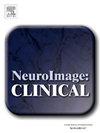zQ175DN小鼠亨廷顿病模型突触密度变化的评估:一项[18F]SynVesT-1研究
IF 3.6
2区 医学
Q2 NEUROIMAGING
引用次数: 0
摘要
亨廷顿氏病(HD)是一种神经退行性疾病,其特征是不自主运动、认知能力下降和精神问题。HD与突触功能障碍和突触囊泡蛋白2A (SV2A)的缺失有关。SV2A可以很容易地通过正电子发射断层扫描(PET)进行量化,使用选择性和高亲和力的SV2A放射性示踪剂[18F]SynVesT-1,我们之前在C57BL/6J小鼠中进行了表征。在这里,我们使用动态[18F]SynVesT-1 PET来表征另一种HD小鼠模型zQ175DN在3个月和6个月(纵向)以及10个月和16个月(横断面)不同疾病阶段的SV2A水平。我们还在16 M时进行了离体SV2A免疫荧光染色和[3H]UCB-J和[3H]SynVesT-1放射自显像,动态[18F]SynVesT-1 PET显示3 M和6 M龄zQ175DN小鼠雌雄之间的VT(IDIF)值相当。3 ~ 6 M时,运动皮质和海马存在明显的年龄效应。3 ~ 10 M时,杂合子小鼠与野生型小鼠无显著差异。然而,在16 M时,运动皮质(- 9.1±3.5%,p = 0.038)、海马(- 7.5±3.3,p = 0.036)和丘脑(- 8.9±3.1%,p = 0.016)的VT(IDIF)在基因型之间存在显著差异。离体分析没有证实在16 M处观察到的缺陷,可能是由于与PET相比敏感性降低。然而,[3H]SynVesT-1和[3H]UCB-J放射自显影显示相同的结果,排除了放射性配体特异性效应。[18F]SynVesT-1 PET在16 M时检测到HD的zQ175DN模型中存在轻度SV2A缺陷,而在更年轻时未检测到明显的SV2A缺陷。本文章由计算机程序翻译,如有差异,请以英文原文为准。
![Assessment of changes in synaptic density in the zQ175DN mouse model of Huntington’s disease: a [18F]SynVesT-1 study](https://img.booksci.cn/booksciimg/2025-1/102303817461777897626.jpg)
Assessment of changes in synaptic density in the zQ175DN mouse model of Huntington’s disease: a [18F]SynVesT-1 study
Huntington’s disease (HD) is a neurodegenerative disorder characterized by involuntary movements, cognitive decline and psychiatric problems. HD has been associated with synaptic dysfunction and loss of the synaptic vesicle protein 2A (SV2A). SV2A can readily be quantified via positron emission tomography (PET) using the selective and high affinity SV2A radiotracer [18F]SynVesT-1 that we previously characterized in C57BL/6J mice. Here, we performed dynamic [18F]SynVesT-1 PET to characterize SV2A levels at various disease stages in another HD mouse model, zQ175DN, at 3 and 6 months (M) (longitudinal) and 10 M and 16 M (cross-sectional). We also conducted ex vivo SV2A immunofluorescent staining and [3H]UCB-J and [3H]SynVesT-1 autoradiography at 16 M. Dynamic [18F]SynVesT-1 PET revealed comparable VT(IDIF) values between male and female 3 M and 6 M old zQ175DN mice. A significant age effect was found in the motor cortex and hippocampus between 3 M and 6 M. From 3 M to 10 M, no significant difference was found between heterozygous and wild-type mice. At 16 M, however, significant VT(IDIF) differences were observed between genotypes in the motor cortex (−9.1 ± 3.5 %, p = 0.038), hippocampus (−7.5 ± 3.3, p = 0.036) and thalamus (−8.9 ± 3.1 %, p = 0.016). Ex vivo analyses did not confirm the observed deficits at 16 M, likely due to the decreased sensitivity compared to PET. However, [3H]SynVesT-1 and [3H]UCB-J autoradiography displayed the same outcome, ruling out a radioligand-specific effect. [18F]SynVesT-1 PET identified mild SV2A deficits in the zQ175DN model of HD at 16 M, whereas no significant SV2A deficits were detected at younger ages.
求助全文
通过发布文献求助,成功后即可免费获取论文全文。
去求助
来源期刊

Neuroimage-Clinical
NEUROIMAGING-
CiteScore
7.50
自引率
4.80%
发文量
368
审稿时长
52 days
期刊介绍:
NeuroImage: Clinical, a journal of diseases, disorders and syndromes involving the Nervous System, provides a vehicle for communicating important advances in the study of abnormal structure-function relationships of the human nervous system based on imaging.
The focus of NeuroImage: Clinical is on defining changes to the brain associated with primary neurologic and psychiatric diseases and disorders of the nervous system as well as behavioral syndromes and developmental conditions. The main criterion for judging papers is the extent of scientific advancement in the understanding of the pathophysiologic mechanisms of diseases and disorders, in identification of functional models that link clinical signs and symptoms with brain function and in the creation of image based tools applicable to a broad range of clinical needs including diagnosis, monitoring and tracking of illness, predicting therapeutic response and development of new treatments. Papers dealing with structure and function in animal models will also be considered if they reveal mechanisms that can be readily translated to human conditions.
 求助内容:
求助内容: 应助结果提醒方式:
应助结果提醒方式:


